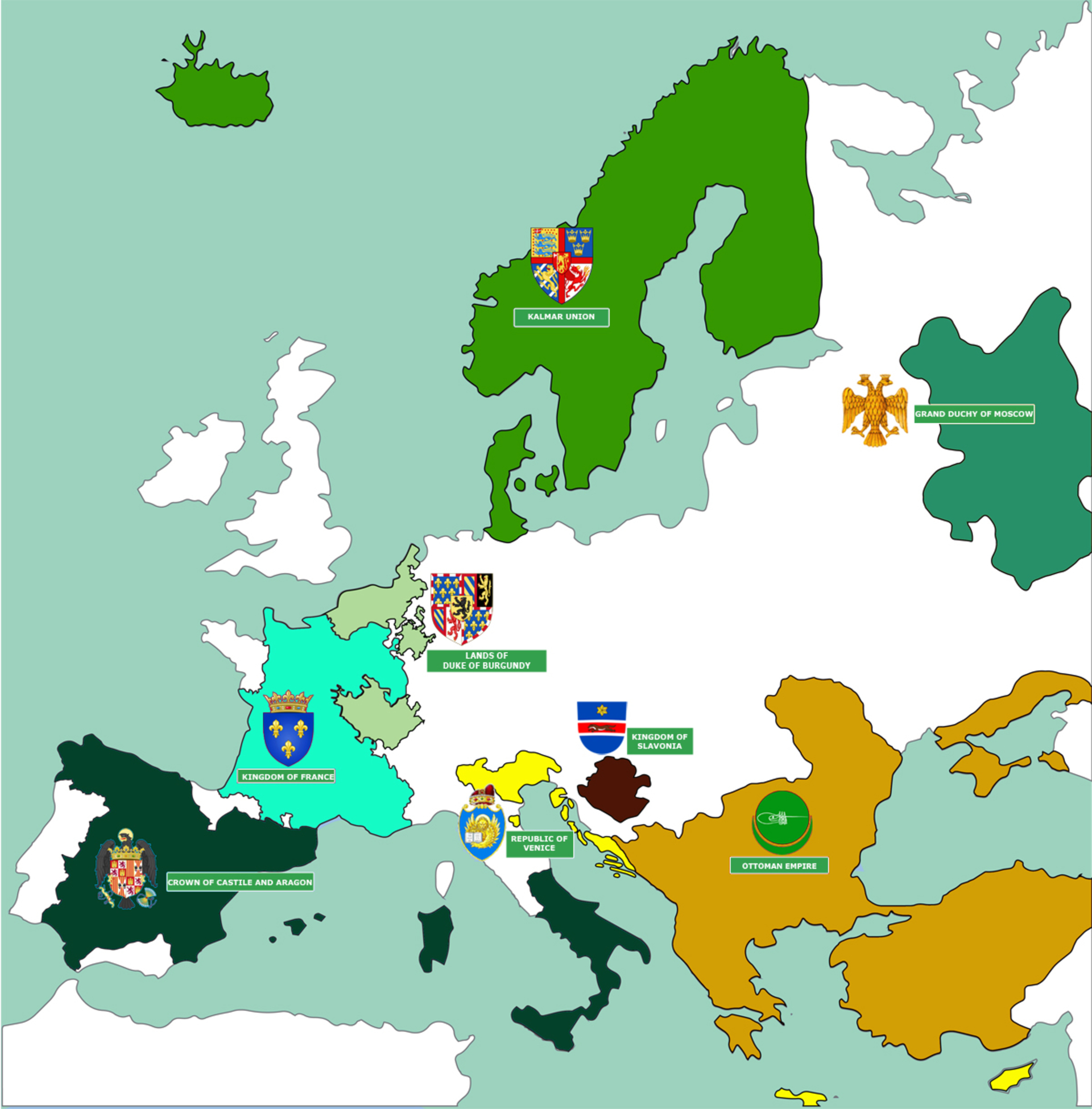The European Championship 1477
In the second half of the 15th century some parts of Europe entered the cultural period of the Renaissance. The Ottoman Empire began an unrelenting spread of its territory in Southeastern Europe. The Burgundian Wars over prosperous lands of the Duke of Burgundy take place in Western Europe. The Grand Principialtiy of Moscow increases its power in the East. England finds itself in the throes of a civil war. The Crowns of Castille and Aragon join their forces.
After conquering Constantinople in 1453, the Ottomans engaged in an unstoppable conquest of Eastern Europe, where they came into conflict with the Bulgarian, Wallachian, Moldavian, Serbian, Bosnian, Hungarian, Croatian, and Slavonian rulers and nobility. Their incursions were made easier by the fact that the new Hungarian king Matthias was preoccupied with the wars against Holy Roman Emperors, Bohemian kings, Hungarian nobility, and with his attempts to expand his territory towards Central Europe. The Bohemians were recuperating from the devastating Hussite Wars, and it was the suppression of Hussitism that finally made the popes and emperors forget their centuries-old rivalries and start thinking about supporting each other, so as to establish their rule over the populace. Seen as how the centre of orthodoxy had fallen, the prince of Moscow started to consider Moscow its successor, and soon after he freed himself from Tatar rule. A civil war was waged in England that gained misleading coherence by being named the War of the Roses, as the roses of Lancaster and York were not the only symbols used, because the struggle for the crown between these two families was only one among many conflicts of that time. Western Europe was reeling from the wars surrounding the Duke of Burgundy, at first for the spreading of his control, and after his death, for succeeding him. On the Iberian Peninsula the crowns of Aragon and Castille united and began their common future. Also, together with Portugal, they became the first states to engage in the search for new spice trade routes to spice-rich India, seen as how the Ottomans controlled the Eastern Mediterranean.
At the same time, the 15th century was the dawn of the Rennaissance, i.e. “rebirth” of interest for the legacy of the classical period, during which a new intellectual movement, Humanism, restored the position of man as an individual, exalted his mind and power, and diminished the position which had previously been reserved for God. A narrow circle of Helenists was not limited only to a handful of cities and royal courts, but has left a mark on whole of Europe – primarily Italian cities, but also the small states comprising the Holy Roman Empire, France, Bohemia, etc. The most influential product of the Rennaissance was, of course, the printing press, invented in Mainz in mid-15th century. In just a few years afterwards, imitators had founded printing offices all over Europe. Its use made the exchange of ideas possible in a wider area and in a shorter period of time which, among other things, influenced the advance of scientific research, as well as the affirmation of common languages and literature written in them, which wrote an end to the superiority of Latin. Until then Latin was not only the only language of education, but was also the only language taught. It had no alternative in education because not much was written in common languages. With the expansion of literature written in common languages, unified fields of exchange and communication in languages formed to fill the vacuum between Latin, which was above them, and local or regional speech, below. Speakers of a wide variety of French, English, or Spanish regional dialects, in which it had previously been hard or impossible to verbally communicate, could now understand each other thanks to print and paper. In this process they began to become aware of the hundreds of thousands, or even millions of people who spoke their language. Nevertheless, there was no single or standard language among the same or similar populace groups, nor was there a single name for a particular language, or the same cultural traditions. Also, among the great majority of people there was no sense of common ancestry, and by that no national solidarity. The use of the names of Roman provinces was also reborn (Italia, Hispania, Britannia, Germania, Belgica, Illyricum, etc.), which will come to be utilised in the naming of territories, states, and peoples that found themselves living in the territory of a particular Roman province. Humanism set the foundations of free thinking, which in later centuries influenced the development of science that was independent from the Christian outlook on the world that had dominated the scientific world until then. Looking in the long term, the development of scientific and philosophical research, proliferation of knowledge and culture through printed books, as well as innovations in the field of art, could not be held back anymore.

Sources
- SOURCES:
- Benedict ANDERSON, Nacija: zamišljena zajednica : razmatranja o porijeklu i širenju nacionalizma, Zagreb 1990.
- Jeremy BLACK, Povijest Britanskih otoka, Zagreb, 2004.
- Fernard BRAUDEL, Civilizacije kroz povijest, Zagreb, 1990.
- Niall FERGUSON, Civilizacija: Zapad i ostali, Zagreb, 2012.,
- Grupa autora, ''Renesansa'':Velika ilustrirana enciklopedija, Zagreb, 2009.
- Grupa autora,''Širenje znanja'': Velika ilustrirana enciklopedija, Zagreb, 2009.
- Petar KORUNIĆ, Rasprava o izgradnji moderne hrvatske nacije : nacija i nacionalni identitet, Slavonski brod 2006.
- Jacques LE GOFF, Civilizacija srednjovjekovnog Zapada, Zagreb 1998.
- Photo: Florence https://pixabay.com/en/florence-italy-aerial-tuscany-839800/
- Sources for maps
- http://www.slovak-republic.org/history/medieval-hungary/
- https://en.wikipedia.org/wiki/Duchy_of_Burgundy
- https://commons.wikimedia.org/wiki/File:Map_France_1477-fr.svg
- http://geacron.com/home-en/?&sid=GeaCron270726
- https://en.wikipedia.org/wiki/Republic_of_Venice
- http://mapsontheweb.zoom-maps.com/post/114584426785/map-of-russian-holdings-showing-which-territory
- https://clionauta.wordpress.com/2012/10/22/robert-kaplan-el-mapa-de-europa-y-la-venganza-de-la-geografia-ii/
